When you first went thru dive school, you were giving a set of fins, and that’s what you used. When you got to your command after, you were giving a set of fins, and that’s what you used (most of the time). But as you started to see other guys at the team using different fins and you would ask, “Hey, where did you get those, and do you like them?” You would hear “they use to issue them” or “I bought them at Lynnhaven Dive” (or insect local dive store name). My point is sometimes you never know what else is out there, and I see a lot of people using gear they don’t like, but it is what they were issued.

In the big picture of dive fins, there are two basic blade types paddles and split. Both fins help you move underwater quicker and smoother, although there are distinct advantages and disadvantages of each kind of dive fin. So how do you choose what is the right fin for you? Well, the easiest way is to try different ones out. Remember also that gone are the days that one fin does it all, or I should say one fin needs to do it all. Many people love Jet fins, but there is no point in carrying them with you in the jungle for river and stream crossing or try and put them on over combat boots for an OTB.
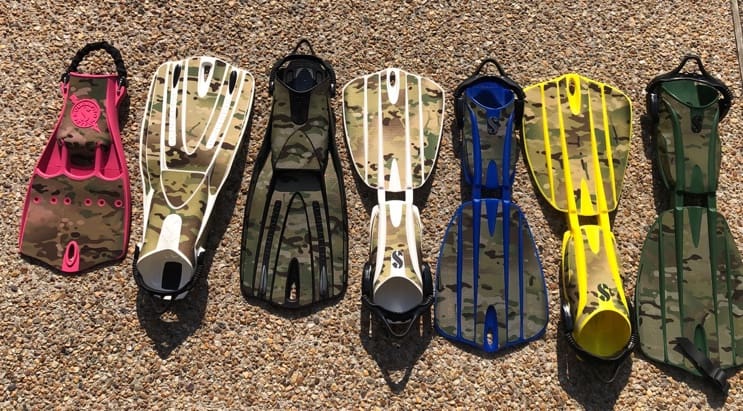
In propulsion capacity and air conservation, split and blade fins often vary.
Split fins are based off of a whale’s tail with a slit down the middle, a relatively new choice for divers. When they came out. Instead of only moving them forward, this slit produces a vortex that lets divers get optimum thrusts and pace underwater.
Split fins act much like a propeller: the slit allows water to flow smoothly from both sides of the blade on the upward fin stroke, resulting in a foil shape. By creating the right lift, this shape helps you to step forward through the water. Split fins do not allow you to move fast in the water, and if you are a slow swimmer, there is a good chance you still will be. Their flow-through nature becomes less effective the harder you kick. Their design also provides less movement if you are pushing a lot of weight thru the water.
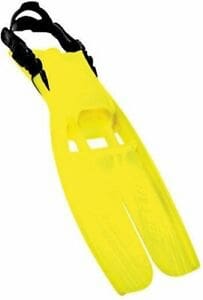
Paddle fins force the water back to help you move forward through the water, and they are more effective than split fins. Paddle fins often differ in length and stiffness, two factors contributing to speed and the kicking force required. Greater stiffness provides you with more forward momentum. Depending on the stiffness, this will make it harder to kick and lead to leg cramps. On the other hand, split fins do not have the rigidity of blade fins since they are relatively light and flexible.
Split fins channel any surface water in and out of their opening rather than over their arms. A spring-like movement is produced by this method, which provides a more robust and solid kick. Usually, you are using a flutter-type kick. It also decreases drag and effort, resulting in greater performance.
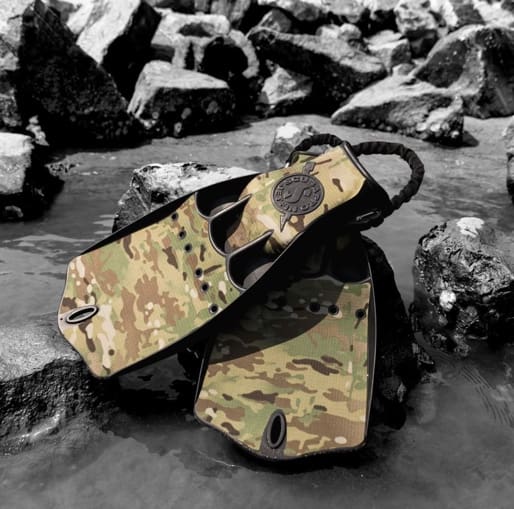
On most paddle fins, you will get spills of water over the sides of their blades. These fins are less powerful than split fins because of this reaction. It also results in more drag, and to go forward; you’ll need to kick more. That being said, many blade fins have ridges and stiffer sides to help fix that problem. The SCUBAPRO SeaWing’s and the Go Sport fins are just a couple of examples of that. I say those two because they are my go-to fins.
Split fins are said to be good for people with ankle or knee issues and divers who easily get cramps. Again, we say the same thing about the SCUBAPRO SeaWing’s They are good for divers who only go straight without turns or moving in tight spaces. With the proper technique, the split fins can provide less joint pressure and pain because your strokes will feel less effective. I have found that they don’t give as much power for bigger divers, and if you have a lot of gear on, like a Dräger, a limpet, and your swim buddy, you have been pulling for two hours because he is “not a strong swimmer”. But they do have a place and a lot of people like them. The downside is. There are only two types, open or closed heal. There have not been any new break through’s when it comes to them.
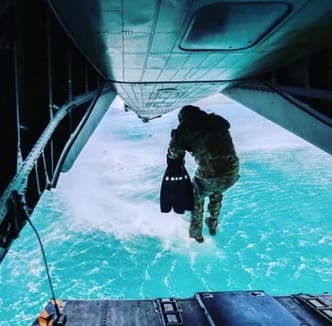
Paddle fins are like the swiss army knife of fins. There are so many different ones to choose from that you can almost always find the right one for the job. They are ideal for use in strong currents or swimming against the tide. They allow you to use different kick styles in more technical dives, like the frog, scissor, reverse, or dolphin, to name a few. Those types of kicks are more effective with paddle-type fins. If you have to pull a lot of weight, like going over the beach with a ruck or have to perform a buddy rescue, blade fins are going to be the best for this. Paddles are also suitable for doing a hook and climb; if you are the guy with the pole doing the hook, paddles are the way to go.
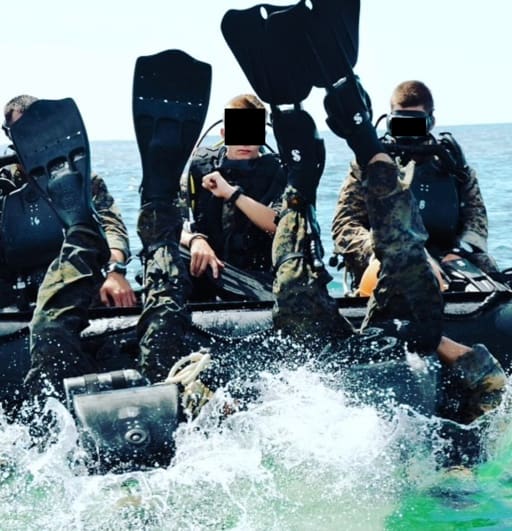
To summarize, split fins have more efficient thrusts and oxygen conservation. They, however, have some drawbacks such as decreased speed and kicking ability. Paddle fins excel in both departments because they give you more strength underwater. Paddle fins may be used in a variety of situations, from combat swimmer to over the beach.
Although split fins have some advantages over paddle fins, it’s difficult to say if they’re better. One of the biggest advantages over the split fins is that there are so many types of paddle fins. It comes down to trying both types of fins out and decide for yourself. I like to look at fins like shoes (I was going to say running shoes, but I do not run, everyone knows it breads cowardness). You are not going to wear the same shoes in the jungle that you would in the mountains. So, if you look at fins like that; you might be able to use just one set but having more than one opens up many more options and helps you do the job better and posable easier.
The fins have the Matbock Skins for SCUBAPRO, Jet fins, Seawing and Go Sport fins.
www.matbock.com/collections/skins/products/scuba-pro-skins


Does anyone ever proofread the SCUBAPRO posts? I’ve yet to read one that wasn’t full of either grammatical errors or typos….
Well I run it thru grammar and word and sometimes they say different things. So I go with ever one I check it with last.
You might want to have someone else read it before you post it. Your current tools are not doing the job.
So you’re saying Duck Feet for the win!
The usual goldmine of info i wish I’d known years ago.
What’re your thoughts on fins for surface swimming?
Iggy,
So if you are doing it barefoot. I really like the SCUBAPRO go fin. Then if you want to use it with boots. Try the go sports. I have giving them to friends to try and they love them. Some guys did a charity swim in Tampa with full gear and used the go sport.
The go sport is a boot cut fin and the go fin is a barefoot fin. I hope this helps.
Thankyou both ER & Ed. I’ve used Typhoons for years (boot cut) for surface but seeing a lot of very short fins around recently coming from distance swimmers, so wondering your thoughts on blade length etc. certainly less to carry but would they have the thrust to move a loaded guy, especially with a floating load, much as Ed points out.
Great to hear from you water guys.
Any time Bro! I used to use the training finz, not sure the brand or model but they worked great in the pool for training, particularly focusing on the pull and minimum kicking just keeping the legs streamed lined. You could kick harder with them and it level the feet so there wasn’t a twist in the ankle. Not sure if that is better or ergonomic. I know a buddy of mine who was a Marine Recon scout used a tiny pair of Force Fins for recce, not site of the load he was carrying or if he was slick.
Thanks again Ed, good info Thats appreciated. Interesting on your MR friend using shorties – makes me think the idea has something to it and others are thinking same. Seems the way to go is to simply experiment. Cheers.
I concur w/ ER on the Go-Fin for pool/work out swims. Very comfortable, I like to wear a thin 0.5mm sock in mine.
In the Teams and training they never got in the weeds on which fins work best on the different mission set. In combat swimming we always used those Bolo split fins. For OTB I preferred a stiffer fin for more power/forward movement dragging gear. Most the time you have to figure it out on your own!